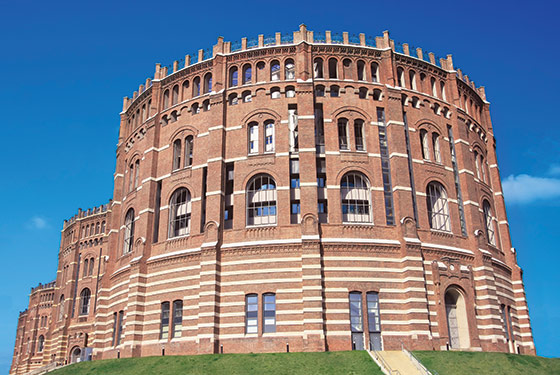Submitted by WA Contents
This Is a Housing Project
United Kingdom Architecture News - Apr 15, 2014 - 10:35 2516 views
Vienna is full of affordable apartments that look great. How’d that happen?

The Gasometer complex in Vienna. (Photo: Getty Images)
During the Bloomberg era, the mayor’s livability crew went idea-hunting in Copenhagen and returned with pedestrian plazas, sidewalk cafés, and bike lanes. If de Blasio is serious about making New York not just pleasant but just, he ought to go on a scouting trip to Vienna, where housing is considered a social good, not primarily a financial tool. In a sleekly modern home for Alzheimer’s patients, each apartment façade is color-coded to make it easier to locate, and hallways wrap around in a continuous circle to prevent dead ends from adding to the residents’ confusion. At the Gasometer complex, celebrity architects refitted a set of immense gas-storage silos with offices, shopping, and affordable apartments. Bike City, another elegantly designed building, is geared to residents who don’t own cars.
These projects emerge out of a 100-year history of high-design, low-cost housing and an apparatus that has placed nearly two-thirds of Vienna’s rapidly growing population in subsidized housing. The city government effectively controls the real-estate market and maintains a housing-research department that puts academic conjecture into practice. The model works because it combines generosity, rigor, and competition. The bidding process fixes construction costs around a modest $200 per square foot, yet teams of developers and architects vie for every project and the city evaluates their plans in terms of sustainability, design, and social justice. “You cannot win a project for housing in Vienna if you don’t meet a high planning and architectural level, and none of it is out of reach in terms of quality for New York City,” says William Menking, a Pratt professor who last year co-curated an exhibit on the subject called “The Vienna Model.” New York’s land and labor costs are higher, but even here, an ingenious design is no more expensive than a lazy one.
Vienna’s system, which produces proportionally far more subsidized housing each year than New York’s private developers do, proves that architecture does more than slather a varnish of luxury on otherwise basic shelter. When every dollar has to multitask, when saving money on lighting bills frees it for better windows, when a hallway needs to double as a social space—that’s when inventive design becomes an urgent necessity. Focus narrowly on the numbers, and you’re apt to forget that housebound seniors have profoundly different needs from those of fresh-out-of-college roommates, middle-class families, artists, or mentally ill refugees from the shelter system. We tend to think of diversity in ethnic and racial terms, but the truth is that the city is pricing out a vast range of the people it desperately needs.
That’s work that architects crave, not just in Vienna but all over the world. This year’s Pritzker Prize winner, the Japanese architect Shigeru Ban, made his reputation by building ostensibly temporary structures for earthquake victims, using paper tubes that could be erected quickly at negligible cost and that have wound up lasting longer than many of their steel-and-concrete counterparts. So far, that spirit of sublime design for the suddenly homeless has inspired New York to tap Ban for a few ultraluxury condos, the fees from which help support his projects in disaster areas. But we could use some of that on-the-cheap beneficence right here.
The prospect of government’s promoting—or enforcing—good design conjures up nightmares of bureaucratic beauty panels and design by committee. But several bodies—the Landmarks Preservation Commission, the Design Commission, the City Planning department, and the mayor’s office—have the power to negotiate, and the City Council can deny approvals. When the city has acted as client it has often insisted on good architecture: Marble Fairbanks’s luminous and welcoming new Glen Oaks Library, for example. The question is not whether this mayor has the authority but whether he will use it to demand the architecture that the city deserves.
If de Blasio’s planners wish to reinforce good intentions with good design, they don’t have to start from scratch—they need only emulate the best of their predecessors’ example. In the waning months of his administration, when Michael Bloomberg was frantically trying to dump on his successor a truckload of faits accomplis, he initiated three massive projects that included a lot of affordable housing. On the Williamsburg waterfront, the development company Two Trees and SHoP Architects proposed putting the old Domino Sugar refinery at the center of a round-the-clock high-rise mini-city. De Blasio’s development team, deputy mayor Alicia Glen and planning chief Carl Weisbrod, eked a few more affordable apartments out of the plan, then gave it their blessing....Continue Reading
> via nymag.com
